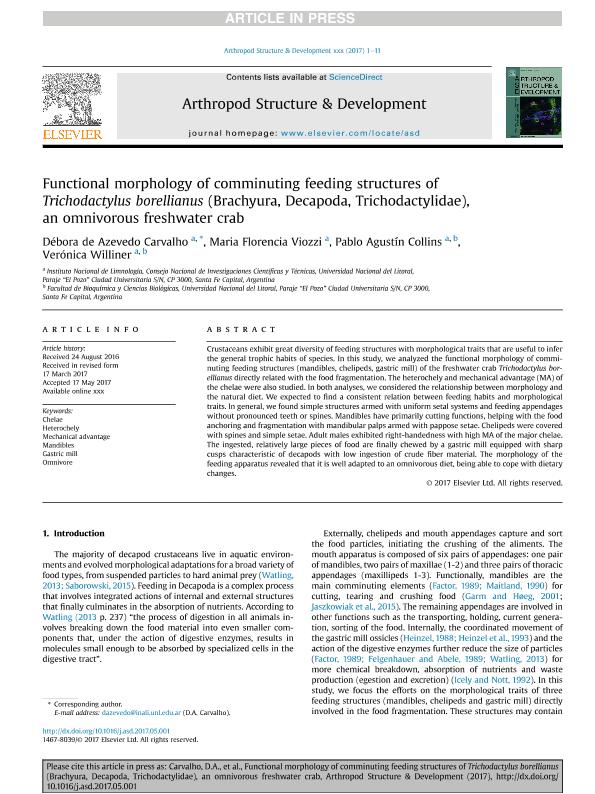Artículo
Functional morphology of comminuting feeding structures of Trichodactylus borellianus (Brachyura, Decapoda, Trichodactylidae), an omnivorous freshwater crab
Fecha de publicación:
07/2017
Editorial:
Elsevier
Revista:
Arthropod Structure & Development
ISSN:
1467-8039
Idioma:
Inglés
Tipo de recurso:
Artículo publicado
Clasificación temática:
Resumen
Crustaceans exhibit great diversity of feeding structures with morphological traits that are useful to infer the general trophic habits of species. In this study, we analyzed the functional morphology of comminuting feeding structures (mandibles, chelipeds, gastric mill) of the freshwater crab Trichodactylus borellianus directly related with the food fragmentation. The heterochely and mechanical advantage (MA) of the chelae were also studied. In both analyses, we considered the relationship between morphology and the natural diet. We expected to find a consistent relation between feeding habits and morphological traits. In general, we found simple structures armed with uniform setal systems and feeding appendages without pronounced teeth or spines. Mandibles have primarily cutting functions, helping with the food anchoring and fragmentation with mandibular palps armed with pappose setae. Chelipeds were covered with spines and simple setae. Adult males exhibited right-handedness with high MA of the major chelae. The ingested, relatively large pieces of food are finally chewed by a gastric mill equipped with sharp cusps characteristic of decapods with low ingestion of crude fiber material. The morphology of the feeding apparatus revealed that it is well adapted to an omnivorous diet, being able to cope with dietary changes.
Palabras clave:
CHELAE
,
GASTRIC MILL
,
HETEROCHELY
,
MANDIBLES
,
MECHANICAL ADVANTAGE
,
OMNIVORE
Archivos asociados
Licencia
Identificadores
Colecciones
Articulos(INALI)
Articulos de INST.NAC.DE LIMNOLOGIA (I)
Articulos de INST.NAC.DE LIMNOLOGIA (I)
Citación
de Azevedo Carvalho, Débora; Viozzi, María Florencia; Collins, Pablo Agustin; Williner, Verónica; Functional morphology of comminuting feeding structures of Trichodactylus borellianus (Brachyura, Decapoda, Trichodactylidae), an omnivorous freshwater crab; Elsevier; Arthropod Structure & Development; 46; 4; 7-2017; 472-482
Compartir
Altmétricas




